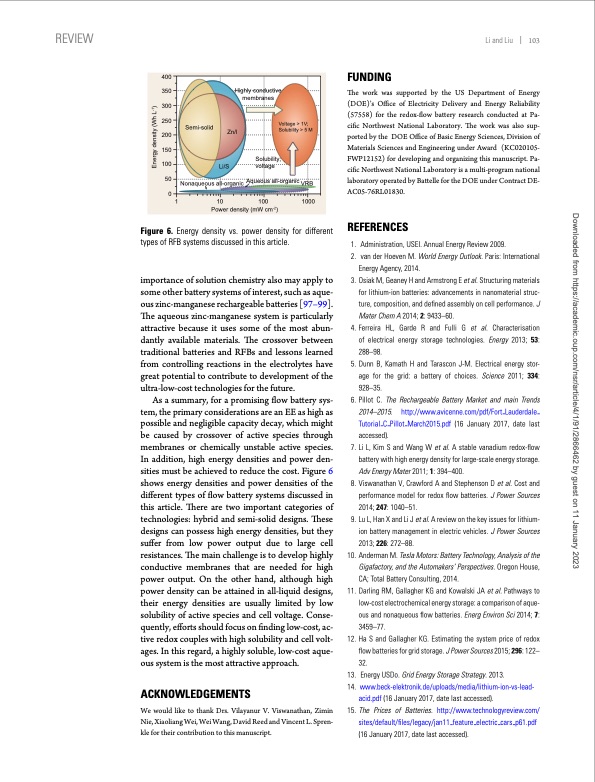
PDF Publication Title:
Text from PDF Page: 013
REVIEW Li and Liu 103 400 350 300 250 200 150 100 50 0 1 10 100 1000 Power density (mW cm-2) Highly conductive membranes Semi-solid Zn/l Li/S Nonaqueous al Solubility; voltage l-organic Aqueous all-organic VR Voltage > 1V; Solubility > 5 M B Figure 6. Energy density vs. power density for different types of RFB systems discussed in this article. importance of solution chemistry also may apply to some other battery systems of interest, such as aque- ous zinc-manganese rechargeable batteries [97–99]. The aqueous zinc-manganese system is particularly attractive because it uses some of the most abun- dantly available materials. The crossover between traditional batteries and RFBs and lessons learned from controlling reactions in the electrolytes have great potential to contribute to development of the ultra-low-cost technologies for the future. FUNDING The work was supported by the US Department of Energy (DOE)’s Office of Electricity Delivery and Energy Reliability (57558) for the redox-flow battery research conducted at Pa- cific Northwest National Laboratory. The work was also sup- ported by the DOE Office of Basic Energy Sciences, Division of Materials Sciences and Engineering under Award (KC020105- FWP12152) for developing and organizing this manuscript. Pa- cific Northwest National Laboratory is a multi-program national laboratory operated by Battelle for the DOE under Contract DE- AC05-76RL01830. REFERENCES 1. Administration,USEI.AnnualEnergyReview2009. 2. vanderHoevenM.WorldEnergyOutlook.Paris:International Energy Agency, 2014. 3. Osiak M, Geaney H and Armstrong E et al. Structuring materials for lithium-ion batteries: advancements in nanomaterial struc- ture, composition, and defined assembly on cell performance. J Mater Chem A 2014; 2: 9433–60. 4. Ferreira HL, Garde R and Fulli G et al. Characterisation of electrical energy storage technologies. Energy 2013; 53: 288–98. 5. Dunn B, Kamath H and Tarascon J-M. Electrical energy stor- age for the grid: a battery of choices. Science 2011; 334: 928–35. As a summary, for a promising flow battery sys- tem, the primary considerations are an EE as high as possible and negligible capacity decay, which might be caused by crossover of active species through membranes or chemically unstable active species. In addition, high energy densities and power den- sities must be achieved to reduce the cost. Figure 6 shows energy densities and power densities of the different types of flow battery systems discussed in this article. There are two important categories of technologies: hybrid and semi-solid designs. These designs can possess high energy densities, but they suffer from low power output due to large cell resistances. The main challenge is to develop highly conductive membranes that are needed for high power output. On the other hand, although high power density can be attained in all-liquid designs, their energy densities are usually limited by low solubility of active species and cell voltage. Conse- quently, efforts should focus on finding low-cost, ac- tive redox couples with high solubility and cell volt- ages. In this regard, a highly soluble, low-cost aque- ous system is the most attractive approach. 32. ACKNOWLEDGEMENTS We would like to thank Drs. Vilayanur V. Viswanathan, Zimin Nie, Xiaoliang Wei, Wei Wang, David Reed and Vincent L. Spren- kle for their contribution to this manuscript. 6. Pillot C. The Rechargeable Battery Market and main Trends 2014–2015. http://www.avicenne.com/pdf/Fort Lauderdale Tutorial C Pillot March2015.pdf (16 January 2017, date last accessed). 7. Li L, Kim S and Wang W et al. A stable vanadium redox-flow battery with high energy density for large-scale energy storage. Adv Energy Mater 2011; 1: 394–400. 8. Viswanathan V, Crawford A and Stephenson D et al. Cost and performance model for redox flow batteries. J Power Sources 2014; 247: 1040–51. 9. Lu L, Han X and Li J et al. A review on the key issues for lithium- ion battery management in electric vehicles. J Power Sources 2013; 226: 272–88. 10. Anderman M. Tesla Motors: Battery Technology, Analysis of the Gigafactory, and the Automakers’ Perspectives. Oregon House, CA; Total Battery Consulting, 2014. 11. Darling RM, Gallagher KG and Kowalski JA et al. Pathways to low-cost electrochemical energy storage: a comparison of aque- ous and nonaqueous flow batteries. Energ Environ Sci 2014; 7: 3459–77. 12. Ha S and Gallagher KG. Estimating the system price of redox flow batteries for grid storage. J Power Sources 2015; 296: 122– 13. EnergyUSDo.GridEnergyStorageStrategy.2013. 14. www.beck-elektronik.de/uploads/media/lithium-ion-vs-lead- acid.pdf (16 January 2017, date last accessed). 15. The Prices of Batteries. http://www.technologyreview.com/ sites/default/files/legacy/jan11 feature electric cars p61.pdf (16 January 2017, date last accessed). Energy density (Wh L-1) Downloaded from https://academic.oup.com/nsr/article/4/1/91/2866462 by guest on 11 January 2023PDF Image | Progress in low cost redox flow batteries energy storage

PDF Search Title:
Progress in low cost redox flow batteries energy storageOriginal File Name Searched:
nww098.pdfDIY PDF Search: Google It | Yahoo | Bing
Salgenx Redox Flow Battery Technology: Salt water flow battery technology with low cost and great energy density that can be used for power storage and thermal storage. Let us de-risk your production using our license. Our aqueous flow battery is less cost than Tesla Megapack and available faster. Redox flow battery. No membrane needed like with Vanadium, or Bromine. Salgenx flow battery
| CONTACT TEL: 608-238-6001 Email: greg@salgenx.com | RSS | AMP |